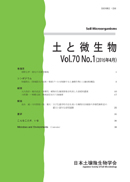Volume 41
Displaying 1-6 of 6 articles from this issue
- |<
- <
- 1
- >
- >|
-
Article type: Article
1993 Volume 41 Pages 1-2
Published: March 01, 1993
Released on J-STAGE: May 31, 2017
Download PDF (219K) -
Article type: Article
1993 Volume 41 Pages 3-6
Published: March 01, 1993
Released on J-STAGE: May 31, 2017
Download PDF (559K) -
Article type: Article
1993 Volume 41 Pages 7-15
Published: March 01, 1993
Released on J-STAGE: May 31, 2017
Download PDF (841K) -
Article type: Article
1993 Volume 41 Pages 17-24
Published: March 01, 1993
Released on J-STAGE: May 31, 2017
Download PDF (699K) -
Article type: Article
1993 Volume 41 Pages 25-29
Published: March 01, 1993
Released on J-STAGE: May 31, 2017
Download PDF (555K) -
Article type: Article
1993 Volume 41 Pages 31-
Published: March 01, 1993
Released on J-STAGE: May 31, 2017
Download PDF (145K)
- |<
- <
- 1
- >
- >|
